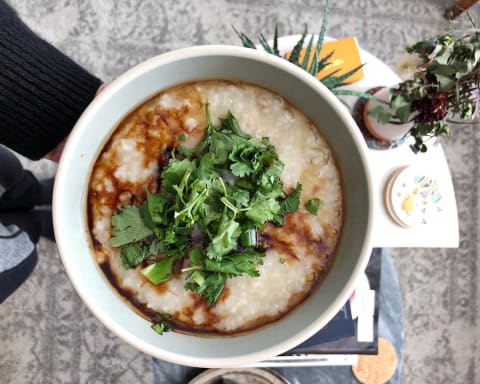A Guide To Congee: The Benefits Of The Ancient, Gut Healthy, Food Plus How To Make It


I know most people don't think of rice porridge as a health food—certainly not on the scale of green juice and kale—but congee is an ancient remedy in Traditional Chinese Medicine for a troubled or tuckered-out digestive system. With just a few ingredients simmered low and slow on the stovetop, it's also the perfect homemade dish when you or your budget is feeling stretched—no cleaning of the juicer necessary.
The health benefits of congee.
Congee has long been a secret weapon of Traditional Chinese Medicine as a salve for the digestive system. Rice is cooked with a much higher ratio of water to grain and simmered until mush, making it both easy to digest and incredibly nourishing for the GI tract.
One particular benefit is hydration, due to the amount of water absorbed by the rice grains throughout the cooking process. Chicken stock or bone broth, which is the second key ingredient for congee, is also hydrating and provides a rich source of collagen. This protein is required to repair and heal the lining of the GI tract, which can be damaged due to diet and lifestyle stressors. Plus, the easier your meal is to digest—and in the case of congee, that's very easy—the better equipped you are to reap the rewards of any protein and minerals coming in.
If you are struggling with a weakened or inflamed digestive system, try preparing this Chinese porridge for a simple, yet powerful healing tool.
How to make congee.
Traditional congee requires little more than white rice and animal protein—usually starchy sushi rice and some bone-in chicken parts—and a pot. For a smoother congee, go with a 10:1 ratio of liquid to rice. For a thicker gruel-like congee, go with a ratio of 7:1. I've designed the recipe below for a happy medium. You can simply simmer the rice in water with whole chicken legs or thighs to create your own broth as it cooks, or if you keep homemade bone broth on hand, you can omit the chicken altogether and use a flavorful stock as a base. Same goes for vegetarian versions: Just use a veggie stock and throw in a few whole mushrooms for added umami.
You'll be shocked by how comforting and delicious your congee is with just these three ingredients (water or stock, rice, chicken). But the fun is really in the toppings. Fresh chopped ginger gives you even more digestive gusto, thinly sliced scallions or chives add an oniony undertone, gluten-free tamari or coconut aminos season it further, and dark sesame oil provides a rich nuttiness.
To make it more of a complete meal, you can top your congee with a fried egg, or if your digestion is feeling up to it, add some steamed bok choy or spinach for a little green.
Simple Chicken Congee
Serves 4
Ingredients
- 2 cups sushi or jasmine rice
- 4 chicken drumsticks
- 8 ounces cremini mushrooms, wiped with a wet towel (optional)
- 5 quarts water or chicken stock
- 2 teaspoons pink Himalayan salt
- 2 tablespoons finely chopped fresh ginger
- 1 tablespoon coconut oil or ghee
- Chopped ginger, scallions, gluten-free tamari, or coconut aminos, and dark sesame oil (optional, but adds flavor)
Method
- In a large pot, combine the rice, chicken, mushrooms (if using), water or stock, and sea salt. Bring to a boil over high heat, then immediately reduce to medium-low. Gently simmer, uncovered, for about an hour, or until the rice is soft, the broth is thickened into a porridge-like consistency, and the chicken is tender.
- Remove the chicken to a medium mixing bowl and pull the meat from the bones using two forks. Discard the bones and return the chicken to the pot along with the ginger. Cook for 5 minutes more.
- Stir the coconut oil or ghee into the congee. Serve the congee alongside additional chopped ginger, scallions, gluten-free tamari or coconut aminos, and dark sesame oil for added flavor.


Phoebe Lapine is a food and health writer, gluten-free chef, wellness personality, culinary instructor, and speaker based in New York. She has a B.A. from Brown University, but but was born and raised in New York City. On her award-winning blog, Feed Me Phoebe, she shares recipes for healthy comfort food and insights about balanced lifestyle choices beyond what’s on your plate. Lapine's forthcoming memoir, The Wellness Project, chronicles her journey with Hashimoto’s Thyroiditis and how she finally found the middle ground between health and hedonism by making one lifestyle change, one month at a time. Connect with her on Instagram and Facebook for more creative clean recipes and inspiration.
